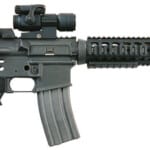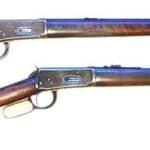
Introduction
The M40 Sniper Rifle is a cornerstone of U.S. Marine Corps precision shooting, embodying over half a century of battlefield effectiveness, technological evolution, and elite marksmanship. Designed for long-range precision and battlefield resilience, the M40 series has been continuously modernized to meet the ever-changing demands of modern warfare. This article explores the development, performance, military use, and historical impact of the M40 Sniper Rifle, delving into its predecessors, manufacturing process, and technological advancements.
Predecessors: The Need for a Standardized Sniper Rifle
Before the introduction of the M40 Sniper Rifle, the U.S. military relied on a variety of sniper rifles, none of which were specifically designed from the ground up for the role. The shortcomings of these rifles underscored the need for a standardized and purpose-built sniper rifle for the U.S. Marine Corps.
M1903A4 Springfield
The M1903A4, based on the legendary M1903 bolt-action rifle, was one of the first standardized sniper rifles used by the U.S. military during World War II. Equipped with the Weaver 330C or M73B1 scope, it offered adequate precision but lacked the optical clarity and ballistic performance needed for modern engagements. Furthermore, the low rate of fire and single-feed bolt-action system made it less effective in dynamic combat scenarios.
M1C/M1D Garand
The M1 Garand, the standard-issue rifle of World War II and the Korean War, was adapted into the M1C and M1D sniper variants. While offering a semi-automatic rate of fire, their side-mounted scope configurations led to awkward reloading and stability issues, making them less effective than contemporary bolt-action sniper rifles.
Winchester Model 70
During the Korean War, the U.S. Marine Corps utilized the Winchester Model 70, a highly regarded bolt-action hunting rifle known for its superior accuracy and smooth action. However, manufacturing inconsistencies in commercial-grade rifles resulted in a lack of uniformity, making it unsuitable for large-scale military adoption.
The Birth of the M40 Sniper Rifle
Recognizing the need for a standardized, accurate, and durable sniper rifle, the U.S. Marine Corps sought a precision rifle built specifically for military sniping. In 1966, they selected the Remington Model 700 bolt-action rifle as the foundation for the new sniper rifle, leading to the development of the M40 Sniper Rifle.
Development and Specifications
- Base Rifle: Remington Model 700 (Short Action)
- Caliber: 7.62x51mm NATO (.308 Winchester)
- Barrel: 24-inch heavy barrel for improved accuracy
- Stock: Initially wood, later replaced by fiberglass McMillan stocks for greater durability
- Scope: Originally Redfield 3-9X Accu-Range, replaced with Unertl 10X in later models
- Accuracy Standard: Sub-MOA (Minute of Angle), capable of 1-inch shot groups at 100 yards
- Maximum Effective Range: 800-1,000 yards
The Marine Corps Precision Weapons Section (PWS) in Quantico, Virginia played a critical role in modifying and enhancing the rifle over time. Unlike other military sniper rifles mass-produced by commercial manufacturers, the M40 series was hand-assembled and maintained by Marine armorers.
The Evolution of the M40 Series
M40 (1966-1977)
The original M40, fielded during the Vietnam War, featured a walnut stock and was praised for its high precision and reliability. However, battlefield conditions highlighted weaknesses such as warping due to humidity and inconsistent scope performance.
M40A1 (1977-1996)
To address these issues, the M40A1 introduced key upgrades:
- McMillan fiberglass stock for improved weather resistance
- Unertl 10X scope for enhanced magnification and durability
- Improved barrel construction to maintain accuracy over extended engagements
The M40A1 remained in service for two decades, seeing action in conflicts such as Operation Desert Storm and Somalia.
M40A3 (1996-2009)
The M40A3 incorporated further enhancements, making it one of the most refined versions:
- McMillan A4 stock with adjustable cheek rest
- Schneider heavy barrel for consistent long-range accuracy
- Picatinny rail system for mounting modern optics
M40A5 (2009-2016)
Recognizing the need for greater adaptability, the M40A5 introduced:
- Detachable box magazine (DBM) for faster reloads
- Muzzle brake with suppressor compatibility
- Improved optics for enhanced battlefield targeting
M40A6 (2016-Present)
The current-generation M40A6 reflects modern sniper warfare needs:
- Modular aluminum chassis for increased durability
- Upgraded optics and night vision compatibility
- Further barrel refinements for long-range precision
Cartridges and Performance
The M40 has consistently used the 7.62x51mm NATO cartridge, a widely adopted precision round known for its balance of accuracy, range, and manageable recoil. However, advancements in sniper ammunition have led to the exploration of alternative calibers, including:
- .300 Winchester Magnum (used in the M24 SWS and Mk 13 Mod 7)
- .338 Lapua Magnum (used by elite military units)
- 6.5 Creedmoor (offering superior ballistic efficiency)
Comparative Analysis: M40 vs. Other Sniper Rifles
| Rifle | Cartridge | Action | Effective Range | Notes |
|---|---|---|---|---|
| M40A6 | 7.62x51mm NATO | Bolt-Action | 1,000 yards | Standard USMC sniper rifle |
| M24 SWS | .300 Win Mag | Bolt-Action | 1,200 yards | Used by U.S. Army |
| Mk 13 Mod 7 | .300 Win Mag | Bolt-Action | 1,300+ yards | Special operations use |
| Dragunov SVD | 7.62x54mmR | Semi-Auto | 800 yards | Russian DMR, not a precision rifle |
| L96A1 (AWM) | .338 Lapua Mag | Bolt-Action | 1,500 yards | British standard sniper rifle |
The Future of the M40 Series
While the M40 Sniper Rifle remains in service, its limited range compared to modern sniper rifles has led to the exploration of replacements, such as the Mk 22 ASR (Advanced Sniper Rifle), which offers:
- Interchangeable barrels for multi-caliber capability
- .300 Norma Magnum and .338 Norma Magnum compatibility
- State-of-the-art optics and suppressor integration
Despite emerging alternatives, the M40 Sniper Rifle’s legacy as the Marine Corps’ dedicated sniper rifle is unmatched, cementing its place in military history and firearms innovation.
Conclusion
The M40 Sniper Rifle has stood the test of time, evolving through decades of battlefield experience and technological advancements. Its legacy is built on precision, durability, and the craftsmanship of Marine Corps armorers. As sniper warfare continues to evolve, the M40 Sniper Rifle’s contributions remain a cornerstone in the history of military marksmanship and precision shooting.
The M40 discussion forums can be found here. (Last visit their certificate was expired but it is a legit site)
If you know of any forums or sites that should be referenced on this listing, please let us know here.



